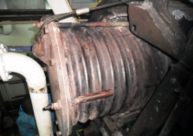Amazon’s Impact on Paper Mill Piping
By: Frank Caprio | On: November 19, 2020

Make Way for Paperboard!

This hose on a pulp pump failed so frequently, the customer used quick-disconnect fittings to facilitate change-outs!
We all have witnessed the shift away from printed media over the past decade. Paper mills that had produced newsprint for generations suddenly found themselves struggling for survival. Due to industry consolidations and closures, five companies now control over 80% of newsprint production in North America. However, other paper-making segments have flourished in recent years. While the onset of the pandemic resulted in unprecedented demand for tissue paper, another market shift was less dramatic but no less important: the increased need for paperboard. As consumers continue their adoption of e-commerce, demand for shipping containers and product packaging made from paperboard has steadily increased. Paperboard includes containerboard (which is used to make cardboard and other boxes) and boxboard (used for packaging everything from frozen foods to pharmaceuticals and health & beauty items). Some forecasters predict that the global containerboard market will grow from $120.6 billion in 2019 to more than $142.03 billion by 2027. Paper mills must add capacity in order to meet this demand; through September 2020, U.S. containerboard production is up 4% over 2019, with mills operating at 95.9% capacity- during a pandemic, no less!
Considerations for Converting Paper Mills

Look for signs of improper modifications. The tie rods on this expansion joint have been detached, which can result in a myriad of problems to both the joint and the surrounding system.
Many paper mills have seized the opportunity to capitalize on this shift in demand by converting their plants from paper to paperboard. The conversion process can be quite complex, as paperboard production requires the ability to produce heavier grades of stock that may contain multiple plies and finishes. When converting to paperboard, major components including the digester, the stock preparation section, the headbox, press section, dryer section, calendaring, broke pulpers, and all of the associated pumping systems may require renovation or replacement. Because every mill conversion is unique, equipment suppliers may conduct engineering studies to ensure that everything will work as intended. Some equipment providers will even build scaled-down pilot plants in order to verify that the intended conversion will produce the desired products safely and efficiently.
This engineering work is conducted during all phases of the project, from development through construction, commissioning, and beyond. Engineers are constantly trying to find ways to improve reliability, increase efficiencies, and reduce complexity. Often, they may not be aware that custom-designed products can be tailored to meet their exact application requirements. In fact, we have witnessed countless applications where an off-the-shelf item was used simply because “it fit” into the intended piping system, without regard to its performance. Short braided pump connectors are a prime example of products that are often applied improperly, as they are frequently exposed to axial movements they cannot accommodate.
Another issue frequently encountered is when a mill makes changes to the system or equipment, but does not consider the effects these modifications will have on the flexible components in the system. Too often, hoses and expansion joints are overlooked altogether during conversions, and the maintenance crews must make product modifications on the fly so the system is able to function. Unfortunately, it is common for these hoses and expansion joints to experience premature failure, as they were not designed to accommodate the new movements resulting from such modifications. Additionally, the stresses that were previously absorbed by the flexible component are now exerted on the piping system and its supports, which may not be strong enough to resist these forces. This can result in cracked welds, pump bearing failures, and more. These issues can be identified and documented during a survey of the mill, and most mill operators are thankful for the help.
Providing Paper Mill Solutions
When a particularly tough application is presented, our engineers can work with the system designers to derive a novel solution. Nowhere is this truer than in paper mills, where the presence of steam, chemicals, and pulping liquors is especially problematic. Working with the engineers through the entire process not only increases their chances of successfully completing the conversion, it is a great way to learn more about their needs. This ensures that you are not only a part of their solution, but it also makes you a sought-after solution provider in the months and years ahead.
Hose Master has assisted with many paper mill surveys over the years, working with our distributors to help the mills increase reliability and safety while reducing downtime and maintenance costs. Put us to work for you by contacting us today at 800-221-2319 or by contacting your local Hose Master representative.

